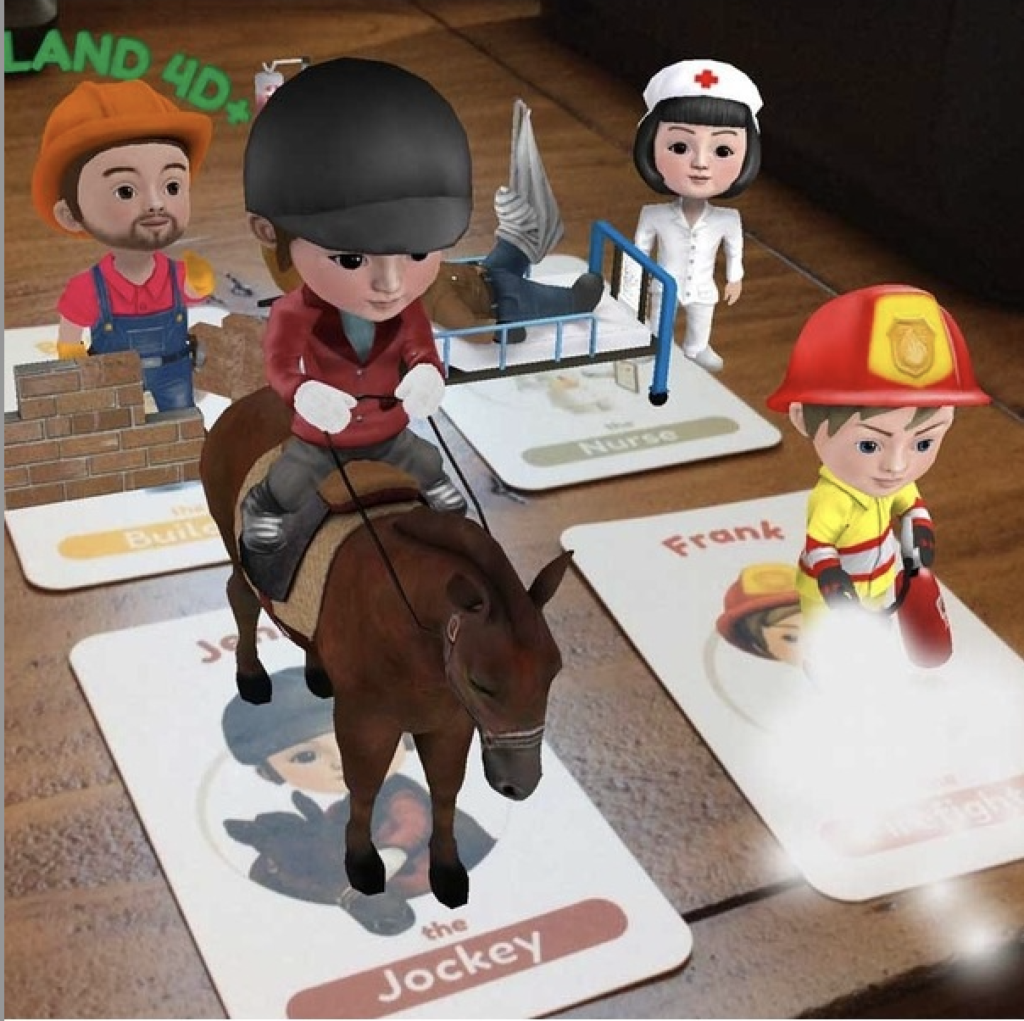Augmented Reality in Language Education: dARe To Know
 Cemil Gökhan Karacan, research assistant in the English Language Teaching department at Istanbul Medipol University and Ph.D. candidate in English Language Teaching at Bahçesehir University.
Cemil Gökhan Karacan, research assistant in the English Language Teaching department at Istanbul Medipol University and Ph.D. candidate in English Language Teaching at Bahçesehir University.
 Elif Mollamehmetoğlu, English and Turkish language instructor at Istinye University in Istanbul and Fulbright scholar (University of Pennsylvania).
Elif Mollamehmetoğlu, English and Turkish language instructor at Istinye University in Istanbul and Fulbright scholar (University of Pennsylvania).
DOI: https://www.doi.org/10.69732/TMYR6702
In this article, we discuss the concept of Augmented Reality (AR) and its place in language education with a specific focus on vocabulary acquisition. We also share our experiences using AR with pre-service English language teachers, textbook designers and material developers, and EFL teachers and students. Finally, we describe strategies for implementing AR along with our observations from language classes where AR was implemented. Furthermore, we examine resistance to educational uses of AR and critically assess its place in language education.
Augmented Reality
Chances are you have used Snapchat or Instagram filters at least once in your life on your smartphone. You may have put dog ears on your reflection on the screen, tried an edgy hair color, or made a chicken dance on your table. Congratulations, you know what Augmented Reality (AR) is. The popularity of AR is clearly on the rise. According to Statista, mobile AR users worldwide have increased from just over 500 million in 2020 to 810 million in 2021. The number of people using AR on their phones alone is expected to increase to 1.1 billion in 2022 (Ripert, 2022).
AR refers to enhancing the real-world environment with computer-generated perceptual information to create an interactive experience (Garzón, 2021). In other words, AR is a new-generation technology that allows people to visualize videos, pictures, and 3D objects, or play an audio file upon scanning a trigger image on a mobile device. A smart mobile device and an AR application are all you need to experience AR. Experts believe AR will become better, cheaper, and more accessible in the future (Garzón, 2021). Many people mistake AR for VR, but the distinction is very simple. When introduced to either, if you feel like you are in a computer-generated 360° environment, it is VR (Virtual Reality). But if you are only augmenting your real-life environment, it is AR. Our primary goal in this article is not to determine whether AR is better than VR. You can’t compare apples and oranges. But if we still had to point out their respective strengths, we would say that AR is more accessible, while VR is more immersive.
Contrary to popular belief, it is easy to utilize and even create AR experiences. If you are willing to do some research and put in the time, you can even discover ways to develop AR applications for free.
Augmented Reality in Language Education
AR is used in nearly all fields, including retail, real estate, automobile, and education. For example, the IKEA Place app lets you virtually place 3D models of furniture in your real-life environment. Language education has benefited greatly from the use of AR, which can transform an ordinary classroom into an engaging learning environment. Parmaxi & Demetriou (2020) conducted a comprehensive review of the literature and found that 23.9% of the articles reviewed used AR to support vocabulary acquisition, 12.7% for reading, 9.9% for speaking, 8.5 for writing, 9.9% for generic language skills while the remaining studies used it for spelling, comprehension, and interpersonal and cultural understanding. According to Fan et al. (2020), using AR apps with activities such as “word spelling games, word knowledge activities, and location-based word activities” can help with vocabulary acquisition. Moreover, using AR for writing instruction was found to contribute to “long-term memory, motivation, and self-regulation of cognitive processes in writing” (Lin et al., 2020, p. 30). In the following section, we’ll be relaying our experiences using AR with different stakeholders in language education.
AR and Pre-service English Language Teachers
We have introduced AR to cohorts of pre-service English language teachers during their 4-year study at the university. Having gained familiarity with AR technology and its use in language education, teachers got quite excited and expressed their intention to implement it in their lessons in the future. Our goal was to widen their perspective on emerging technologies and their place in the classrooms. In an academic study that we conducted, pre-service English language teachers were also found to have intentions to integrate AR into their future classes mainly because of the tool’s usefulness and participants’ sense of self-efficacy (Karacan & Polat, 2022). If you are interested in learning about the teachers’ perspectives on this topic, see their reflections on the use and creation of AR and AR-based materials.
AR and Curriculum Designers and Instructional Material Developers
Seeing AR’s progress, curriculum designers and instructional material developers from both state and private institutions have consulted with us and are now considering the integration of AR into their work. As a matter of fact, the ministry of education in Turkey has already piloted an AR-enhanced coursebook project called MebAR. If you are a pre or in-service teacher, coursebook designer, or developer interested in emerging technologies but uncertain about their future place in the field, rest assured that your ideas and competencies will matter. AR has found a place in EFL coursebooks, and it will continue to do so (Kurtz, 2020).
AR and English Language Teachers
We have conducted workshops and webinars with language teachers and witnessed their amazement, especially with the ease of use of AR applications, although with some exceptions, as will be explained in the following sections. Today, many teachers take advantage of AR-enhanced flashcards and other popular apps such as Quiver Edu.
AR and EFL Students
Now, let’s talk about the main focus of this article: how students use AR. Students from all levels are excited and motivated to try AR (Parmaxi & Demetriou, 2020). Students use AR to animate static images from the coursebook through creation-based applications. In some of our classes, we have animated vocabulary items to enhance understanding and boost motivation.
Quiver is a popular app that preschoolers and/or primary school students can use to animate their drawings and present their work (Redondo et al., 2020). The Quiver EDU app has a very rich AR library where you can download coloring pages and get started right away.
As an extracurricular activity, we have assigned a daily conversation activity for beginner to pre-intermediate level students on a well-known AR application, Mondly AR. Mondly AR is a mobile AR app with an animated chatbot and speech recognition system. It uses the entire world as a learning environment and provides a platform for practicing real-life conversations with your very own virtual language teacher.

An easier way to do the same thing is to use Instagram or Snapchat filters for students to vocalize characters that they create in class. For example, they can create a Superhero in the classroom and give it a voice and an animation through those filters, just like the well-known Voki App.
Brick-and-mortar stores such as Walmart and online stores like Amazon sell affordable AR flashcard sets with themes such as jobs, animals, objects and space, etc. See, for example, this AR-supported flashcard set. AR flashcard sets are a great teacher resource owing to their availability, ease of use, and simplicity. However, while using emerging technology such as AR, we never want to reduce the level of interaction and communication between students.
We have implemented the aforementioned flashcards in a number of ways. For example, we distributed object cards individually to all students, grouped them randomly, and asked them to create a collaborative story with the object cards they hold, followed by an AR-enhanced presentation using those object cards.
Rather than employing static pictures, teachers can introduce target vocabulary using AR in several ways, allowing students to experience objects from all angles, thus increasing the likelihood of learning more related words. For instance, AR flashcards can be used for practicing the vocabulary of the professions, where students pick a card and observe each character’s outfit and other 3D items. This allows students to get an idea of what an engineer may look like and what they do. This activity can be followed by an oral presentation in which students name the characters and describe their job duties. Higher-level students can be asked to write about the daily routine of people with particular occupations. AR-supported presentations can follow as a post-writing activity.

AR flashcard sets on the theme of objects are also very popular in the market. By objects, we mean every object found in nature ranging from sand to swamp. Students can be grouped under categories of objects such as animals, nature, and food and create their own AR-enhanced dictionaries that they then present to other students. Information-gap activities can also be applied in pairs. In this kind of activity, one party has the flashcard while the other has the list of vocabulary items. They then work together to match the parts of an object (as a vocabulary item) with the correct words. This way, both students have a chance to review a vocabulary item with its related words and discuss those words with the 3D view.
Some AR-supported flashcards have interactive features that pop up when two sets of related cards are joined together. For example, if students connect the monkey and banana cards together, it triggers an interactive scene where a monkey is eating the banana.
Another activity would be shuffling the flashcards and asking students to alphabetize them and match beginning and ending syllables to form words. AR-supported flashcards are also useful for memory games or ordering activities. In this kind of activity, each student has a card. In groups, they discuss and try to order the objects by size. For early childhood education, AR-supported flashcards that cover pronunciation, the alphabet, and sounds are also available on the market. In low-resource classrooms or classrooms where the use of mobile phones is limited, teachers can use the showcase of AR experience as a gamification element. For example, the student with the most creative story about life on Jupiter gets to present the story with AR.
AR helps 21st-century skills development (Papanastasiou et al., 2019). In their literature review on AR uses in the language classroom, Karacan and Akoğlu (2021) proposed a homework project to support this development. Most textbooks include end-of-the-unit projects such as posters, booklets, brochures, and digital newspaper designs. These projects can be completed using AR. In this way, students use the 4C’s (Critical thinking, Collaboration, Creativity, and Communication) while searching for an appropriate AR platform, choosing suitable multimedia, collaborating and communicating with peers, and all in all, bringing about technologically supported, innovative, and quality products. Throughout the process, teachers should encourage and guide students as they explore. Eventually, teachers will be amazed at what students come up with.
Going Against the Tide
Can you dARe to use emerging technologies in your class?
If you are a language educator that uses AR technology in your classes, you might feel like you are going against the tide. You might have encountered skeptical reactions from colleagues who have not used it in their classes before or from those who don’t use much technology at all. We are not proposing AR as a silver bullet or a tool that should be used all the time. That has never been our stance. No single tool, method, approach, or technique can be a final answer to language learning (drops the mic). We would like to make it clear that using technology for the sake of using it is never the objective.
Prejudices Against Augmented Reality in Education
For the last five years, we have been working with AR in language education, and we have come across many professionals, ranging from university professors to school teachers. We often encounter resistance to emerging technologies. We believe this resistance comes from uncertainty and technological inexperience. As stated, educators often misperceive emerging technologies and newly introduced platforms as the saviors of language pedagogy, but this is not the case. Prior to criticizing something new, we think it is important to have a solid understanding of how it works and what good it might accomplish. We are not arguing that lecturers and teachers must all know about AR for language education. As teachers, we all know to let students go and explore and amaze us with their creations. We argue that AR can be motivating and provide a more immersive language learning experience. We believe that AR has a promising future in education.
Has AR Passed the Educator’s Check?
Karacan and Akoğlu (2021) provide a detailed review of AR “in terms of learning theories, learning pedagogies, teachers, students, culture, infrastructure, and sustainability” and conclude that “AR does not strike a pose as the greatest choice for language learning” due to not being designed specifically for instructional purposes and not fitting with a certain learning theory (p. 76).
However, enough studies showed the positive effects of AR on language learning to say that AR passed the educator’s test and that it does have a place in the language classroom as one of the many tools teachers can use to enhance their practice.
A Call for Collaboration
Dear professionals all around the world, if you think we share similar interests and wish to collaborate on a project or research, please get in touch with us or leave us a comment below.
Acknowledgments
Our deepest gratitude goes out to our beloved university professor Assoc. Prof. Tuncer CAN for widening our perspectives and supporting us throughout our 4-year study and beyond.
Useful Links
AR We Ready : Augmented Reality in Language Education
AR We Ready? [WORKSHOP] – Augmented Reality in Language Education: Workshop
References
Fan, M., Antle, A. N., & Warren, J. L. (2020). Augmented reality for early language learning: A systematic review of augmented reality application design, instructional strategies, and evaluation outcomes. Journal of Educational Computing Research, 58(6), 1059-1100.
Garzón, J. (2021). An overview of twenty-five years of augmented reality in education. Multimodal Technologies and Interaction, 5(7), 37.
Karacan, C. G. (2019). Exploring factors that predict pre-service English teachers’ intentions to use augmented reality using decomposed theory of planned behavior. [Master’s thesis, Bahçeşehir University]. The Council of Higher Education Database. https://acikbilim.yok.gov.tr/handle/20.500.12812/591679
Karacan, C. G., & Akoğlu, K. (2021). Educational augmented reality technology for language learning and teaching: A comprehensive review. Shanlax International Journal of Education, 9(2), 68-79.
Karacan, C. G., & Polat, M. (2022). Predicting pre-service English language teachers’ intentions to use augmented reality. Journal of Digital Learning in Teacher Education, 1-15.
Lin, V., Liu, G. Z., & Chen, N. S. (2020). The effects of an augmented-reality ubiquitous writing application: A comparative pilot project for enhancing EFL writing instruction. Computer Assisted Language Learning, 1-42.
Papanastasiou, G., Drigas, A., Skianis, C., Lytras, M., & Papanastasiou, E. (2019). Virtual and augmented reality effects on K-12, higher and tertiary education students’ twenty-first century skills. Virtual Reality, 23(4), 425-436.
Parmaxi, A., & Demetriou, A. A. (2020). Augmented reality in language learning: A state of the art review of 2014–2019. Journal of Computer Assisted Learning, 36(6), 861-875.
Redondo, B., Cózar-Gutiérrez, R., González-Calero, J. A., & Sánchez Ruiz, R. (2020). Integration of augmented reality in the teaching of English as a foreign language in early childhood education. Early Childhood Education Journal, 48(2), 147-155.
Ripert, D. (2022, February 2). Top 5 augmented reality trends for 2022. Entrepreneur. https://www.entrepreneur.com/article/412819

